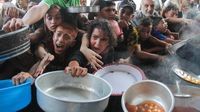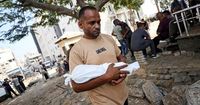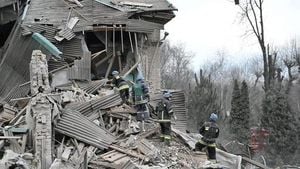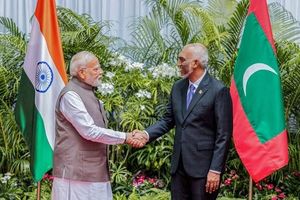In the narrow, besieged strip of Gaza, famine is no longer a looming threat — it has arrived, devastating lives daily. Children like Noor and Ezz Aldin, born amidst conflict and hardship, know hunger intimately. Noor, just four years old, wakes each day pleading for chocolates and biscuits, the biggest number she can count, while her infant cousin Ezz Aldin, born during the early months of war, asks only for bread, a staple now almost impossible to find.
These stories are not isolated. In Gaza City’s Al Shifa hospital, the heartbreaking image of six-week-old Youssef al-Safadi, whose fragile body bore the marks of malnutrition, underscores a grim reality. Youssef died recently, his family unable to provide formula milk or supplements, which, if found, cost upwards of $100 — a price far beyond reach for most.
The Palestinian Health Ministry has reported a surge in deaths from severe malnutrition, with 15 people, including four children, dying within 24 hours recently, and another 10 succumbing shortly thereafter. Over 100 aid organizations have raised alarms about mass starvation spreading across Gaza, with people collapsing in the streets, the United Nations’ humanitarian agency confirms.
Gaza’s food markets and shops lie in ruins or are utterly empty. Once a land of agricultural abundance, exporting strawberries to Europe and self-sufficient in dairy and poultry, the enclave now faces astronomical prices and scarcity. For example, a watermelon that once cost $5 now fetches $250 if it can be found at all. Avocados, once grown by the tonne and affordable, have vanished from tables. Even seafood, a traditional dietary staple, is scarce due to fishing restrictions and ongoing conflict.
Many residents survive on a single meal a day, often at night, consisting of rice, pasta, or canned beans — luxury items turned essentials. Drinking water is often the only sustenance for long stretches. The war has shattered not only Gaza’s infrastructure but the very fabric of daily life, with university campuses reduced to rubble and students forced to take exams online, battling hunger and fear simultaneously.
One second-year student described the experience of studying amid airstrikes and starvation. Final exams were taken on empty stomachs, with the constant drone of warplanes overhead. Conversations between friends revolve not around lessons but around whether they have eaten, how dizzy they feel, and how they manage to keep going despite the crushing conditions.
Healthcare professionals paint a dire picture. American surgeon Ambereen Sleemi, working at Nasser Hospital in Khan Younis, reports neonatal intensive care units filled with malnourished babies and pregnant women suffering from severe nutritional deficiencies. Similarly, critical care nurse Elidalis Burgos has witnessed malnutrition among patients and even healthcare workers, who show signs of muscle wasting and frailty from prolonged starvation.
The death of Abdulrahman Al-Ghalban, a 17-year-old with cerebral palsy who required specialized nutritional milk, highlights the acute shortages. His family struggled to feed him in his final days, a tragic emblem of the broader crisis.
Efforts to provide aid face immense hurdles. Although Israel lifted its blockade in late May, only limited aid has entered Gaza since. Approximately 4,500 aid trucks have been allowed in since then — a fraction compared to the 600 trucks daily before the blockade. The Gaza Humanitarian Foundation (GHF), backed by Israel and the United States, remains the primary distributor of food, but its aid centers have become deadly flashpoints. The United Nations reports that over 1,000 Palestinians have been killed at these sites since the new aid system began, many due to stampedes or Israeli Defense Forces gunfire, which Israel claims was in self-defense amid chaotic conditions.
Despite the ongoing crisis, the U.S. State Department maintains support for the GHF, emphasizing the complexities of operating in a war zone. Spokesperson Tammy Bruce noted that nearly 85 million meals have been distributed at GHF centers, though she acknowledged the challenges of expanding distribution amidst conflict.
However, many aid agencies argue that these meals are insufficient for Gaza’s two million residents. The World Food Program highlights “astonishing levels of desperation,” with around 100,000 women and children suffering from severe acute malnutrition. The situation is so severe that even aid workers, who should be the most protected, report suffering from starvation.
On the ground, charity kitchens try to fill the void. In Gaza City, one kitchen manages to cook about 15 pots of lentil soup daily, but it is a mere drop in the ocean compared to the massive crowds desperately seeking food. Volunteers describe children climbing over one another, holding out pots and pans, hoping for a meal.
The human toll is staggering. Families mourn children lost to starvation and war, like the man who wept over seven relatives killed after days of hunger and an Israeli drone strike near al-Tabin School in northern Gaza. The war and blockade have not only destroyed livelihoods but have systematically starved a population, leading many to declare these acts war crimes.
The people of Gaza are not merely victims of unfortunate circumstances; they are enduring a siege that deliberately cuts off food, medicine, and basic necessities. As one resident put it, “We were killed by the Israeli occupation. We were starved by the Israeli occupation. We were besieged by the Israeli occupation.”
The international community faces a moral crossroads. While aid agencies call for an immediate end to the blockade and increased humanitarian access, ongoing violence and political complexities hinder progress. The United States has dispatched senior envoys to Europe to discuss ceasefire and humanitarian corridors, but the path to relief remains fraught.
In Gaza, hunger is a daily, brutal reality that no child should endure. Noor’s innocent requests for chocolates and Ezz Aldin’s simple cry for bread echo the desperate plea of a population trapped in a cycle of violence and deprivation. The world watches, but the silence and inaction only deepen the tragedy unfolding in this besieged land.





